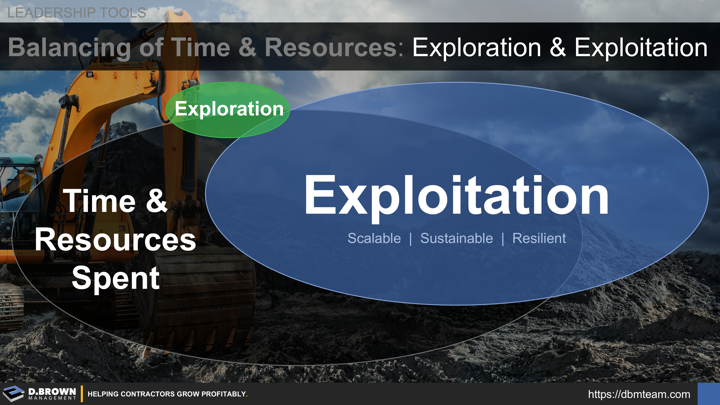The right balance of exploration and exploitation is the dichotomy faced at all levels whether it is making strategic choices about major resource allocations or a Foreman experimenting with new production methods as part of the continuous improvement process.
The diagram and this article can help you think through how you allocate resources.
Start with the assumption that a significant amount of your time and resources are not being spent deliberately on exploration or exploitation activities. This is simply waste. It will never go to zero and even if that were theoretically possible, there is a strong argument to be made for a certain amount of slack in a system to create flexibility and resiliency. Remember the stress-performance curve and focus on staying in the performance zone.
Now think about your balance of exploration and exploitation. A good point to start is at a 10:90 ratio. What dictates whether more or less resources should be allocated to exploration should be based on modeling out the exploitation opportunities over time and what the key risk variables are.
For example, if you are in three relatively stable and counter-cyclical markets that you are currently exploiting then you can afford to invest less is exploration. On the other hand, if your models show that you have a 50% chance of needing to replace two-thirds of your income in the next 3-5 years, then you need to expand your exploration efforts.
One of the highest leveraged choices a contractor makes is what market(s) they choose to work in including industry sectors, scopes of work, geography, project delivery methods, and customers.
- What are the strategic market choices that your business is currently built upon?
- What are the strategic market experiments that will likely build your business in the future?
The only choices a contractor makes that is even more highly leveraged that this are the decisions about the people who make these strategic choices.
Strategic market choices are about leadership changes in direction and are largely irrelevant without great operational execution. Great operational execution requires progressively improving the standards and that requires a balance of exploration and exploitation with a clear feedback loop.
- What are the 25 most frequently repeated tasks performed in your business?
- Do you have some level of standards for each? (See Job Instruction from 1940s)
- Who is Directly Responsible Individual (DRI) for documenting and updating each of these standards?
- What job role is directly responsible for doing the task? If it is a high-frequency task, it is likely multiple people.
- What job role is directly responsible for ensuring the task is done correctly?
- What percentage of the time do you expect those two roles to spend exploring improvements to the standard method of doing the task?
- How is feedback on successful exploration (Production Experiments) integrated into the standard (#3 above) and shared across the whole team (#4, 5, and others)?
You can't continuously improve your way into the right strategic market choices, but great execution can make even a moderately good strategic choice successful.

